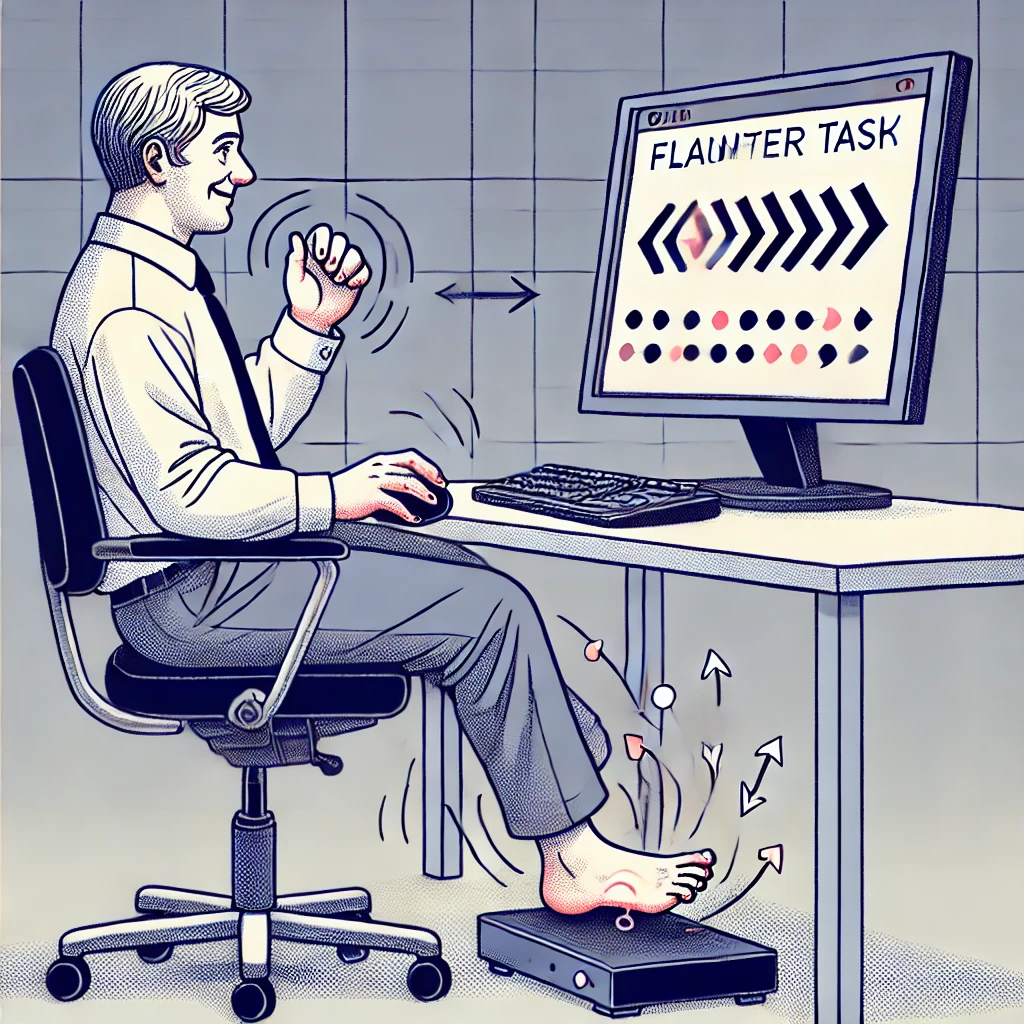Fidgeting in adults with ADHD may serve as a compensatory mechanism to sustain attention during cognitively demanding tasks, particularly during correct task performance and when reaction time variability is low.
Highlights:
- Fidgeting was significantly higher during correct trials compared to incorrect trials, suggesting it may aid in task performance.
- Increased fidgeting was observed in later stages of the task, indicating a potential role in sustaining attention over time.
- Participants with lower reaction time variability exhibited more fidgeting during later trials, supporting the idea that fidgeting helps maintain arousal and attention.
- The study highlights the importance of not discouraging fidgeting in adults with ADHD during attention-demanding activities, as it may be beneficial.
Source: Frontiers in Psychiatry (2024)
Major Findings: Fidgeting vs. Attention in Adults with ADHD (2024)
1. Fidgeting During Correct Task Performance
The study found that adults with ADHD fidget more during correct trials of the Flanker task compared to incorrect trials. This suggests that fidgeting might help these individuals perform better on tasks that require attention and cognitive control. Specifically:
Increased Frequency: Participants exhibited a higher number of fidgets during correct trials, indicating that frequent fidgeting may be linked to better performance.
Variability and Intensity: The fidgeting during correct trials was also more variable and intense, meaning the movements were less predictable and more vigorous when participants were getting the answers right. This variability and intensity could help maintain focus and alertness.
2. Sustained Attention Over Time
As the Flanker task progressed, participants showed an increase in fidgeting, particularly during the later stages. This finding indicates that fidgeting might play a role in sustaining attention over longer periods:
Early vs. Later Trials: There was significantly more fidgeting during the last 30 trials compared to the first 30 trials. This pattern suggests that as the task became more routine and possibly more monotonous, fidgeting helped participants stay alert and engaged.
Attention Maintenance: The increase in fidgeting over time supports the theory that these movements help individuals with ADHD maintain attention during extended tasks.
3. Fidgeting and Reaction Time Variability
Participants with lower reaction time variability, meaning those who responded more consistently and less erratically, showed more fidgeting during the later trials of the task. This relationship highlights the role of fidgeting in enhancing sustained attention:
Consistent Performers: Those with more consistent reaction times tended to fidget more as the task progressed, suggesting that fidgeting helps keep their attention steady and prevents lapses in focus.
Attention Aid: The finding that consistent performers fidget more supports the idea that these movements might be a compensatory mechanism to help maintain cognitive performance.
4. Correlation with ADHD Symptom Severity
The study introduced new variables to quantify fidgeting and found that these variables were significantly correlated with ADHD symptom severity. This validation indicates the potential for standardizing fidgeting measurements in future research:
New Fidget Variables: The study defined and measured fidgeting in terms of frequency, variability, and intensity. These variables showed a strong correlation with the severity of ADHD symptoms as measured by standardized rating scales.
Relevance and Standardization: The strong correlation suggests that these new variables are relevant and effective for understanding the role of fidgeting in ADHD, paving the way for more standardized and replicable research methods.
Study Overview: Fidgeting vs. Cognitive Performance in Adult ADHD (2024)

The study aimed to design a framework to quantify meaningful fidgeting variables and test the relationship between fidgeting and performance on a cognitive task (the Flanker task) in adults with ADHD.
Sample
- Participants: 70 adults diagnosed with ADHD
- Age Range: 18–50 years
- Average Age: 30.5 years
Methods
- Screening & Assessment: Structured clinical interview. ADHD symptom ratings (childhood, current self, and current observer). Actigraphy devices attached to the left wrist and right ankle during the Flanker task.
- Flanker Task: Measured response inhibition and attention by requiring participants to identify the orientation of a central target arrow among distracting flankers.
- Data Collection: Actigraphy data recorded at 500 Hz for movement analysis during the task.
- Analysis: Examined the relation between task performance, reaction time variability, and fidgeting. Introduced new variables to quantify fidgeting: number of fidgets, fidget variability, and fidget intensity.
Limitations
- Sex Imbalance: More female participants, especially in the group with a fidget ball, which could affect generalizability.
- Capturing Impulsive Movements: The defined fidget variables might not effectively capture all aspects of impulsive movements.
- Single Task Focus: Findings are based on the Flanker task only; results may vary with different cognitive tasks.
- Potential Arbitrary Significance: High number of comparisons could lead to some variables appearing significant by chance, necessitating further research for validation.
Mechanisms of Fidgeting in ADHD: Why the Movements?

1. Neurobiological Factors
Noradrenergic & Dopaminergic Systems
Individuals with ADHD often have poorly regulated noradrenergic and dopaminergic systems. These neurotransmitters are crucial for regulating attention and arousal.
Dysregulation in these systems can lead to hyperactivity and fidgeting as the brain attempts to compensate for low levels of stimulation and maintain alertness.
Motor Area Activity
Altered activity in the motor areas of the brain is commonly observed in individuals with ADHD.
Increased motor activity, such as fidgeting, may be an expression of this altered brain function, reflecting an internal drive to enhance sensory input and cognitive arousal.
2. Cognitive & Behavioral Factors
Self-Regulation of Attention
Fidgeting can serve as an involuntary mechanism to self-regulate attention, particularly during tasks perceived as cognitively demanding or monotonous.
It helps to maintain an optimal level of arousal needed for sustained attention and cognitive performance.
Response to Cognitive Load
When faced with tasks that require high cognitive control, individuals with ADHD may engage in fidgeting to cope with the increased cognitive load.
This behavior helps manage the stress and demand of the task, allowing for better focus and performance.
3. Psychological Factors
Anxiety & Restlessness
Higher rates of anxiety and restlessness in individuals with ADHD can lead to increased fidgeting as a coping mechanism to alleviate these feelings.
Fidgeting provides a physical outlet for the excess energy associated with anxiety and restlessness.
Attention-Seeking & Stimulation
The need for constant stimulation and difficulty in maintaining attention may cause individuals with ADHD to fidget.
This behavior helps to keep them engaged and prevent boredom, thereby improving their ability to focus on the task at hand.
4. Environmental & Situational Factors
Task Environment
The environment in which a task is performed can influence the level of fidgeting. For example, a more stimulating or engaging environment may reduce the need for fidgeting.
Conversely, a monotonous or less engaging environment can increase fidgeting as a way to seek additional stimulation.
Task Complexity & Duration
More complex and longer tasks are likely to induce higher levels of fidgeting as individuals with ADHD try to maintain their focus over time.
Fidgeting increases as a task progresses, particularly during the later stages when maintaining attention becomes more challenging.
Conclusion: Fidgeting May be Beneficial in Adult ADHD
This study highlights that fidgeting in adults with ADHD serves as a compensatory mechanism to sustain attention and improve task performance during cognitively demanding activities.
By defining and quantifying new variables for fidgeting, the study revealed a significant increase in fidgeting during correct trials and as tasks progressed, supporting the notion that these movements help maintain arousal and focus.
The correlation between the newly defined fidget variables and ADHD symptom severity validates their relevance and potential for standardization in future research.
These findings suggest that allowing fidgeting in controlled ways could be beneficial for adults with ADHD, especially in settings requiring prolonged attention, such as work or academic environments.
References
- Study: A quantitative analysis of fidgeting in ADHD and its relation to performance and sustained attention on a cognitive task (2024)
- Authors: Ha Min Son et al.







